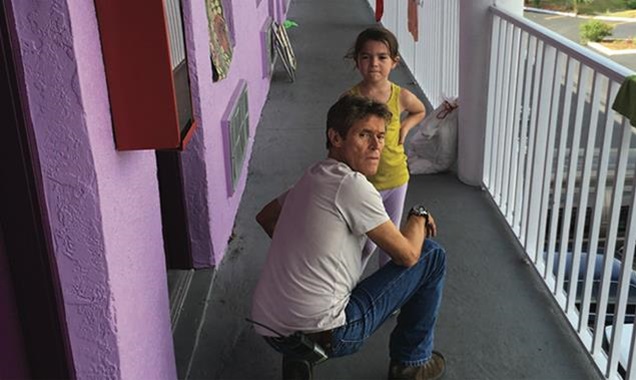
- Festivals
The Florida Project: Life Around the Corner from Disney World
A highlight of the Directors Fortnight, the bolder and more innovative sidebar of the Cannes Film Festival, The Florida Project is Sean Baker’s eagerly-awaited follow up to Tangerine, the ultra-modest feature that put him on the international cinema map.
Centering on a precocious girl (Brooklynn Prince), during one eventful summer, his fifth feature boasts Baker’s biggest budget to date, and an ensemble cast that includes a discovery of a six-year-old-girl, some unprofessional actors, and a vet performer like Willem Dafoe.
Taking its title from Disney’s working name for Disney World in Florida, this fascinating feature is full of ironies, not least because of the poor and destitute life that its characters live in a region that neighbors the theme park of the giant corporation, constructed for escapist amusement—and capitalist profit.
A humanist, who refuses to judge his on-screen personae, Baker is aware of those ironies but he does not ask for the viewers’ pity or even sympathy for his characters, instead opting for presenting in a realistic manner the kind of lifestyles seldom depicted in mainstream Hollywood movies
His characters live in The Magic Castle and Future Land, two run-down motels near Disney World, that are garishly painted and so named in order to cash in on the famous nearby tourist attractions.
Baker is not the first indie filmmaker to understand the importance of having children as protagonists, and in this tale he shows the events largely from the point of view of a young, extremely perceptive girl named Moonee, played vibrantly by newcomer Brooklyn Prince.
The Florida Project represents a point of departure for Baker in many significant ways. His last two films, Starlet in 2012, and Tangerine in 2015, the groundbreaking, iPhone-shot transgender tale, were features that were distinctly rooted and shot in California milieus.
Though shot on 35mm, The Florida Project still employs the guerrilla filmmaking used on Tangerine. However, Baker says that the reason he went with the ‘more controlled, classical feel of 35mm,’ is because “I was trying to tell the story through the eyes of a 6-year-old. And her world is always somewhat candy-coated, so I wanted it to have an extra gloss, for the film to be rich.”
Baker sees the benefits and beauty of using both digital and 35mm, though he prefers celluloid because digital “doesn’t give you that organic quality that celluloid brings.’
As for casting, with few exceptions (Dafoe), Baker opted for using local residents, based on a firm conviction: “I didn’t want to just bring in a bunch of outsiders, Los Angeles people, to play Floridians.’
He met Brooklynn Prince, who is 6, in a casting call: ‘She came in from Orlando, and within seconds, we knew she was our lead.’ He also feels Brookline possesses the potential of becoming a star, but for now he describes her as the “best child actor he had ever seen.”
Tangerine elevated realism to a kind of pop verité—that feature was at once a movie and a cultural phenomenon. “I really loved discovering that style, so I wanted to continue exploring it. Being in the Floridian environment, there’s a sort of style that’s imposed on you. We all embraced those Floridian colors in order to achieve hyper-reality to everything.”
The ultra-bright colors offer sharp contrast with the darker and gloomier aspects of the characters’ lives; they are poor and homeless. In the film’s more upsetting moments, we observe the characters’ sadder realities—they are the victims of unbridled and greedy capitalism.
To be sure, Moonee is not the sole persona and we get to meet her mother, Halley (Bria Vinaite), a loud, unruly, not exactly a model of parenthood but full of heart and love woman, and the hotel manager, Bobby (Dafoe), who becomes sort of a saintly protective figure. Early on he defuses a fight, then obeys the owner’s demands by keeping Halley in line, and when a child molester shows up, he quickly sends him away. In one amusing scene, a couple of honeymooners arrive, thinking they’re booked into a Disney hotel, only to later realize their mistake.
Visually, too, the film’s focus is narrow—by design. Baker and his cinematographer, Alexis Zabe, almost always place the camera at Moonee’s height, emphasizing authenticity, which contributes to the overall emotional impact.
Moonee and her mother’s routine activities engage our attention because their characters are so vividly drawn and realistically played. Moonee and her pals have their access to their own theme park, their playground. It is their sense of wonder and ability to find magic and mischief—they experiment with recreational arson–in their otherwise bleak reality that gives the film an injection of energy and a necessary sense of joy.
Though different in subject matter and style, The Florida Project, like Tangerine before it, deals with marginal, underprivileged characters, depicted from the inside with vibrant energy and candy color (pink pastel).
Thrilling with its striking sun-blasted visuals, imaginative and heartbreaking in its emotional (but unsentimental) tone, The Florida Project is a major contribution to the greatest cinematic portrayals of childhood.